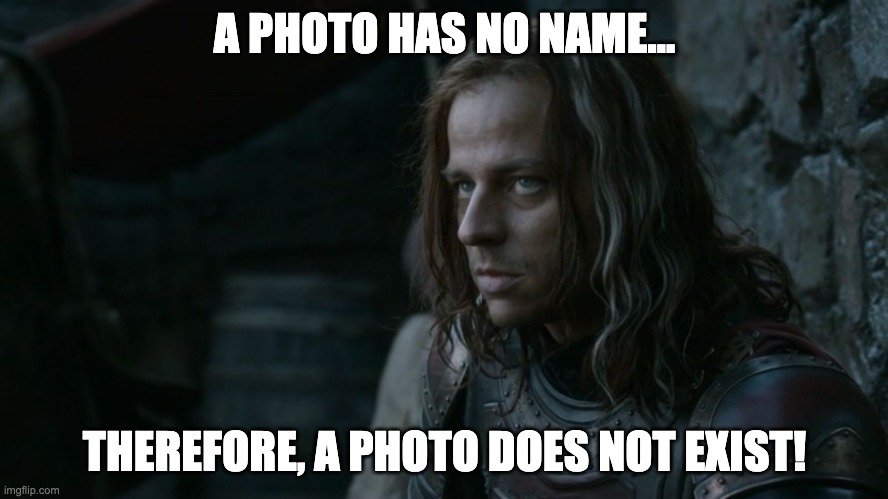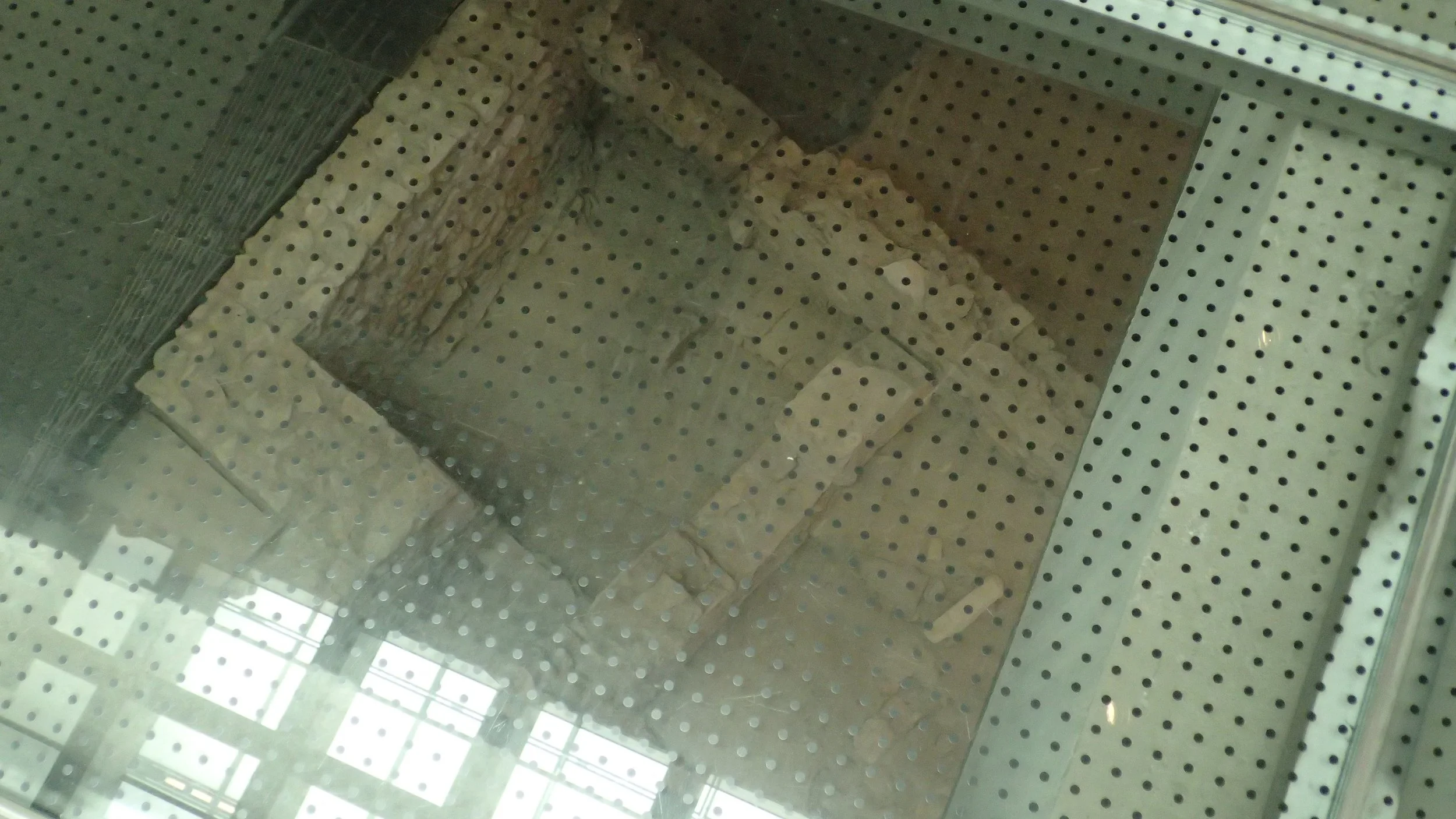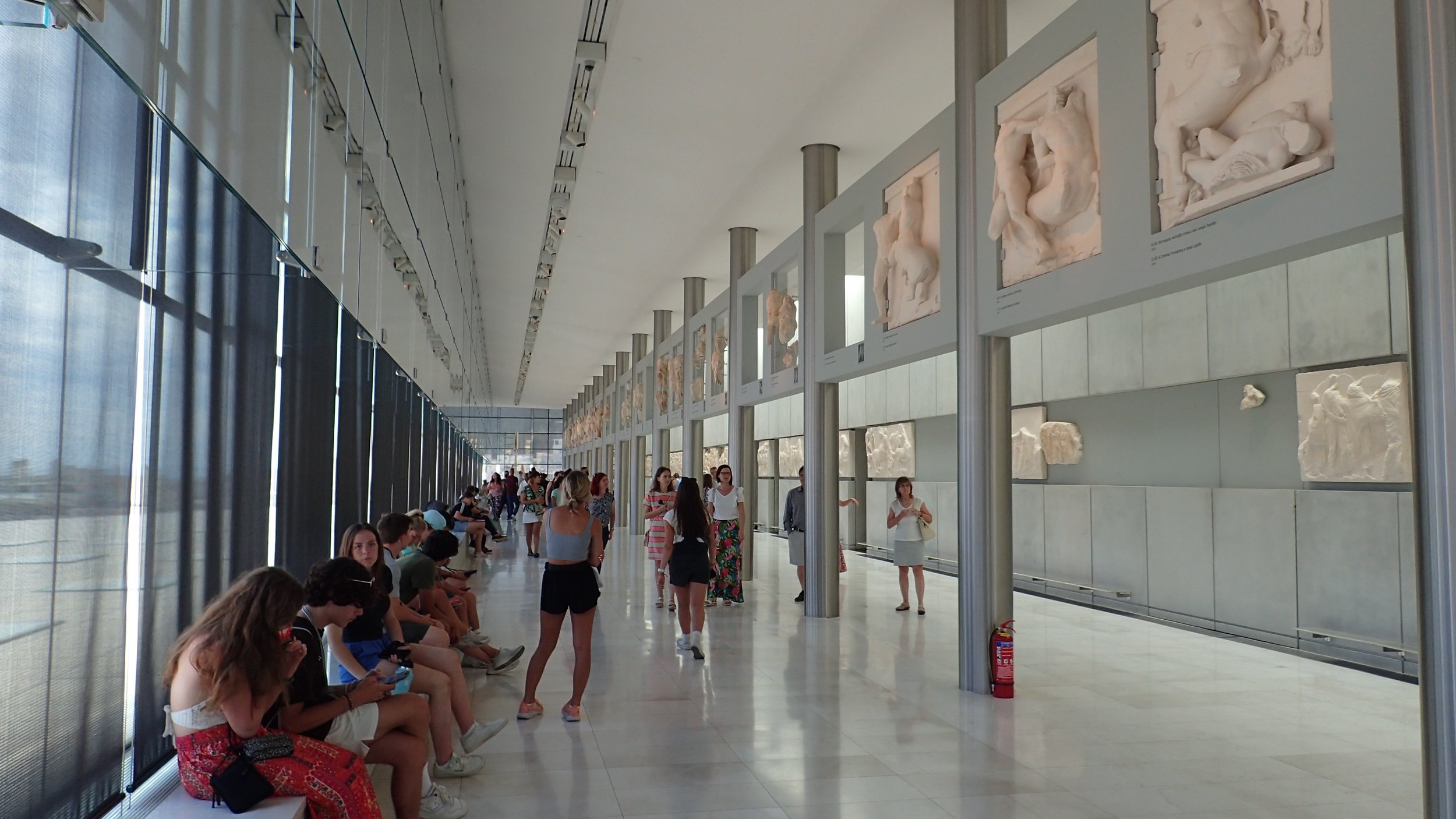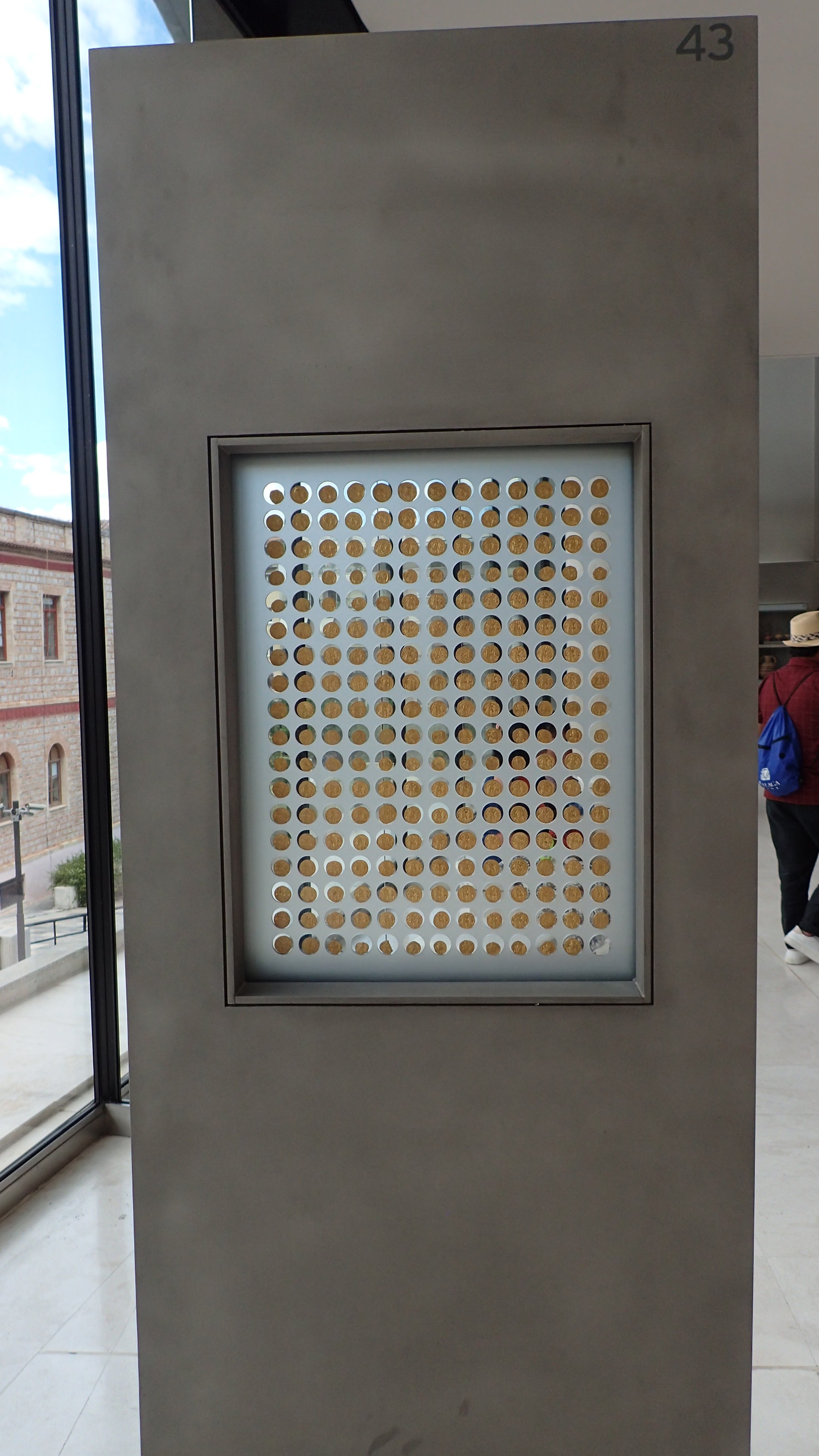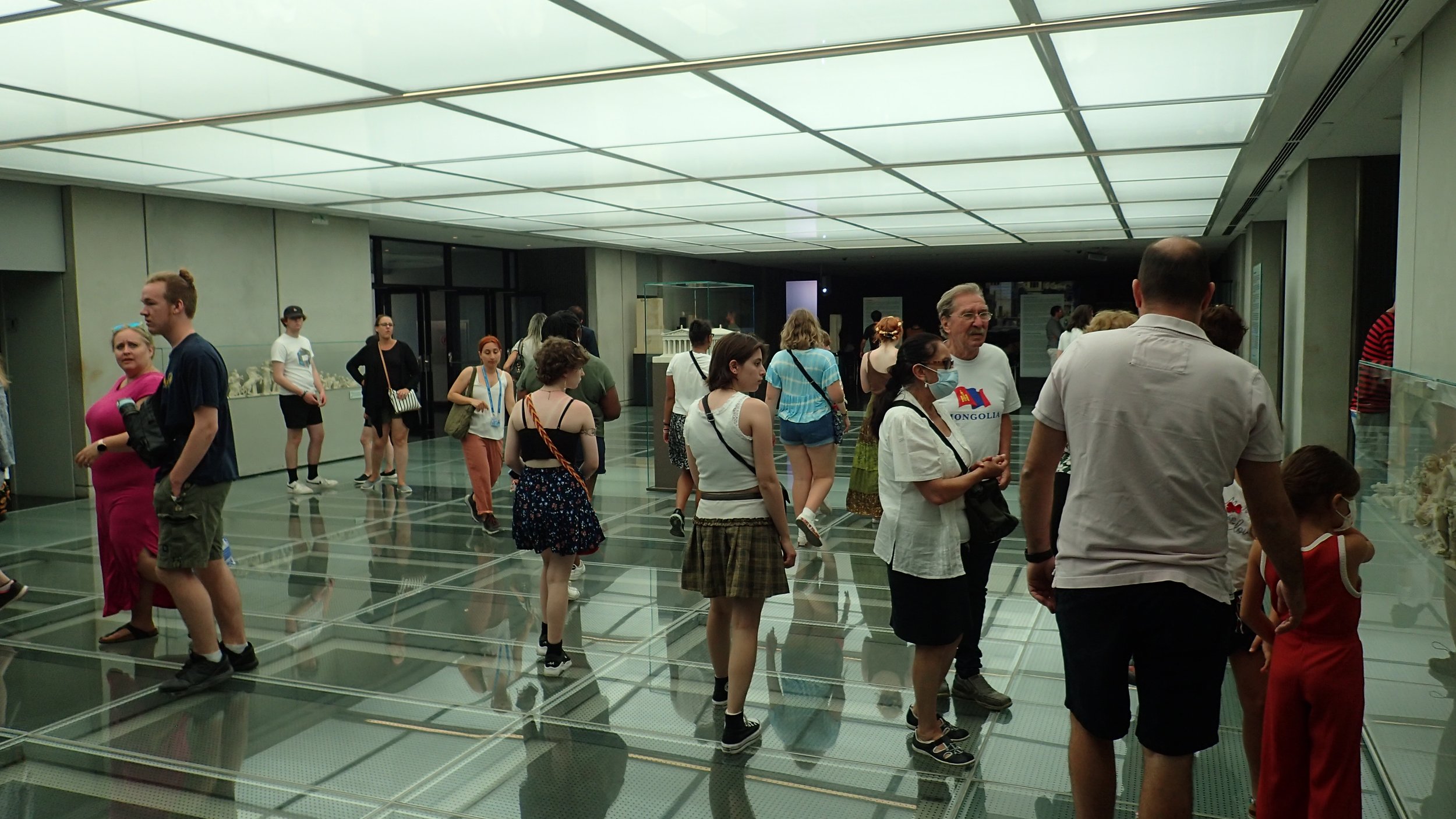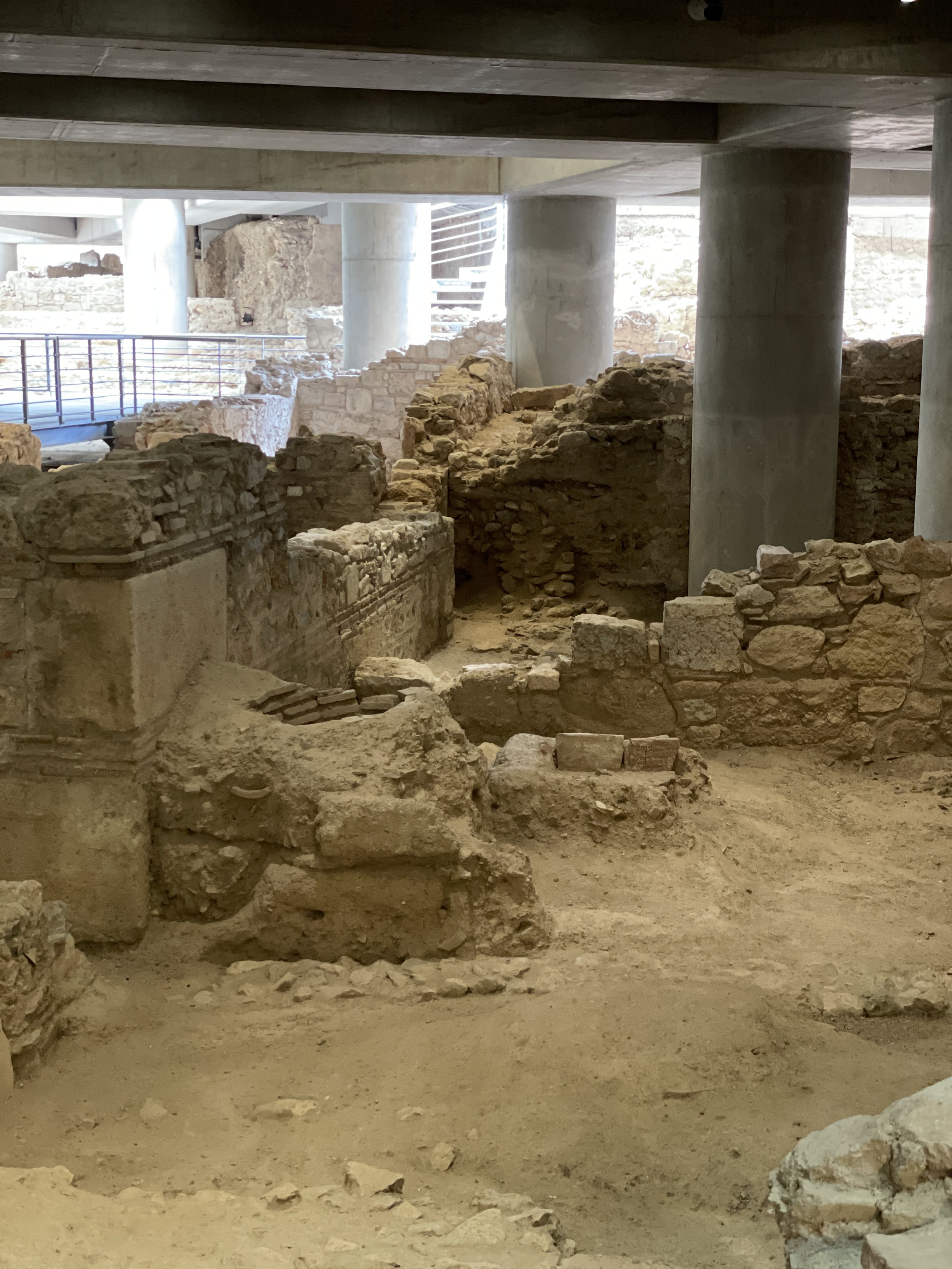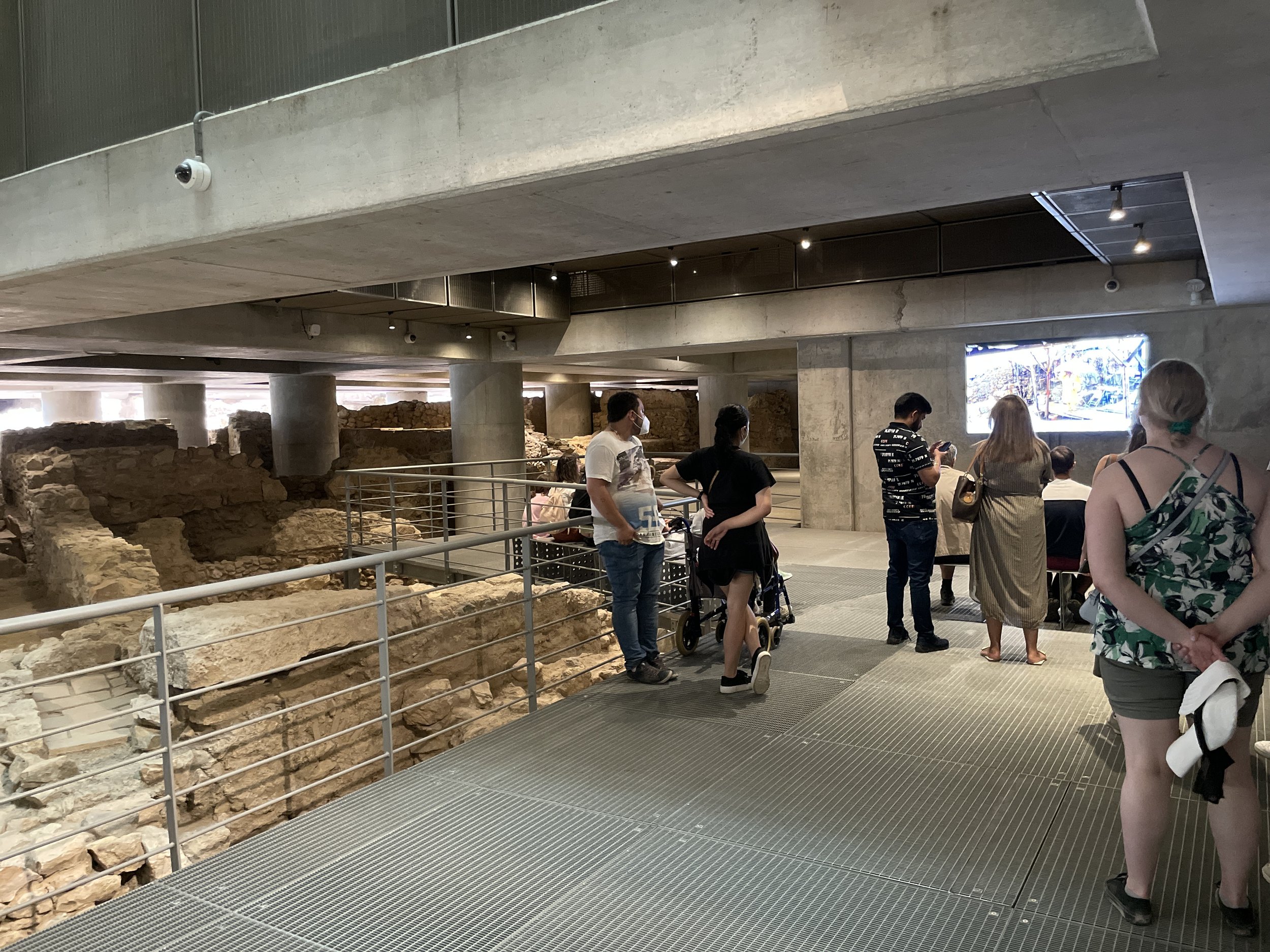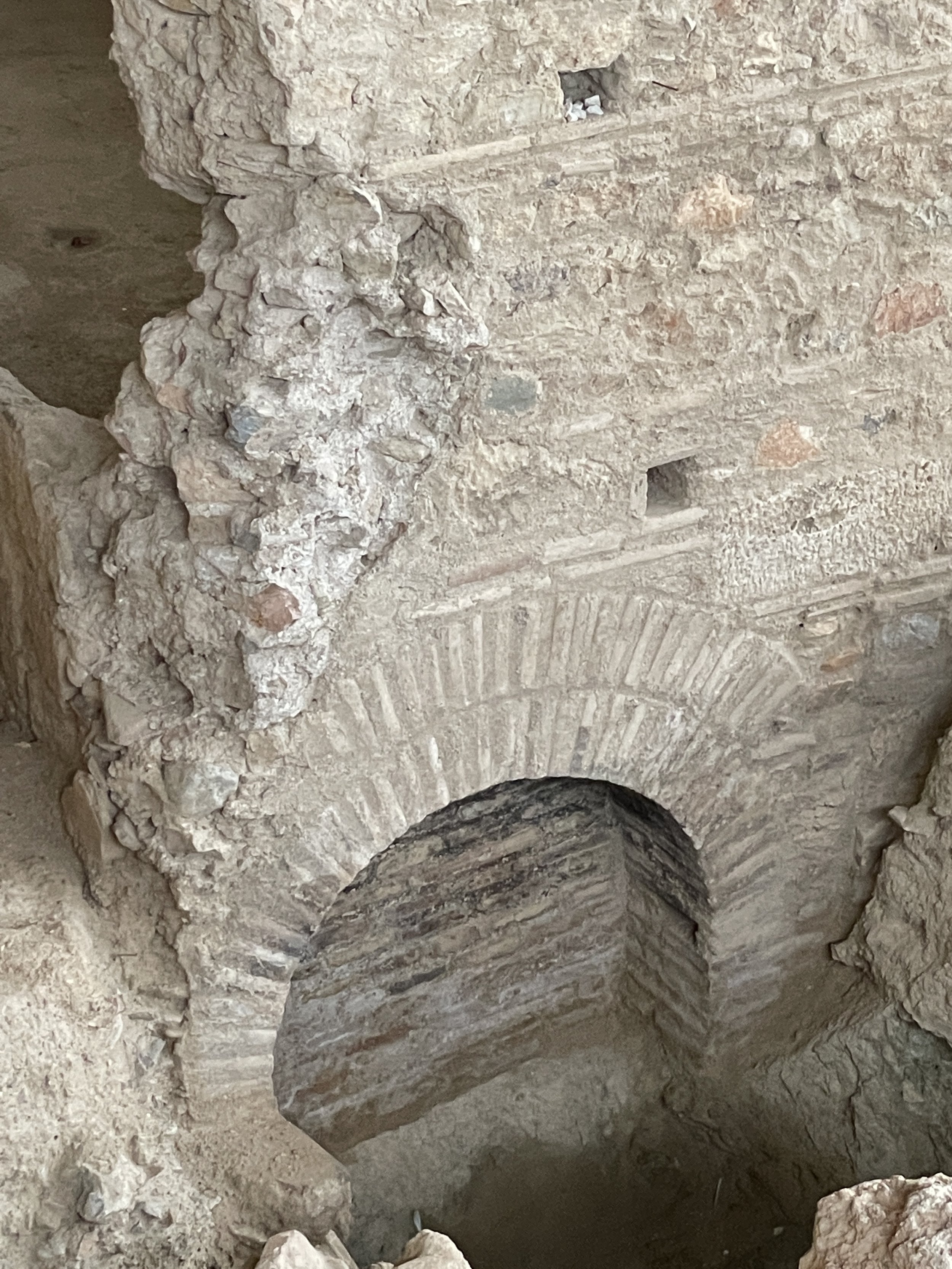They Are Engaged!
As you can tell by the title I am continuing my discussion on engagement in the Museum. Today we will be focusing on the Acropolis Museum in Athens. I wanted to write an intensive analysis, but who am I kidding? The way my mind works, the writing turned into more of a creative non-fiction narrative with some general observations. And isn’t that what Rogue History is about? Telling History from a different perspective? From a creative non-rigid analytical method. A historical creative non-fiction approach?
This Post Will Be Photo Ladened. Which I Think Many Of You Prefer.
Entrance to Acropolis Museum. Photo: Scott Coleman, 2022.
Excavated structures at museum entrance. Photo: Scott Coleman, 2022.
When you first walk down the stairs to the Acropolis Museum entrance you are greeted with the above. The excavated area stretches beyond this focal point and is well under the structure of the museum. It is a mix of Greek and Roman architecture with steel walkways that lead you through a patchwork of urban-domestic structures, workshops, baths, roads and other forms of infrastructure. However, before you can go down to the excavated site, you need to buy your tickets — of course.
DISCLAIMER: If you are an undergraduate student, graduate student or working professionally in any form of ancient, Greek, Roman, or Medieval History, I would Highly Recommend getting a membership to one of the institutes that represents your country and field. For me, this was the Canadian Institute in Greece, and with an institute membership I was eligible to receive a museum pass that grants access to any Ministry of Culture and Sport-administered museum;
FOR FREE!
I will provide a list of Institutes at the end of this post.
Looking East towards the Hekatompedon (in the background). Photo: Scott Coleman, 2022
After you purchase your tickets, you are ushered to a coat/bag check (backpacks are not allowed past the entrance), then you walk through a turnstile and are presented with a grand gallery of Archaic and Hellenistic artifacts, glass floors that allow you to see the excavated areas underneath and a staircase leading to the west-pediment Hekatompedon.
When you get to the top of the stairs and hang an immediate right, you enter the south end of the museum where many Archaic Acropolis statuaries are displayed. However, due to some unfortunate “accidents,” you are no longer allowed to take pictures. So, I have none, but click this LINK to see some of the statues from the exhibit.
Looking down into main gallery entrance from second floor. Photo: Scott Coleman, 2022.
Sculptures believed to be part of the west pediment of the Hekatompedon. Photo: Scott Coleman, 2022.
Mosaic under glass observation floor in main gallery entrance. Photo: Scott Coleman, 2022.
As I continued my journey throughout the museum I noticed a few things about how people interacted, or engaged, with the exhibits. First, people don’t care about rules and took pictures of the statues whenever possible. Phones were either being disguised or just pulled out in plain sight and snapping away. The employees who watched over the exhibit would dash across the room, bellowing “No pictures, please. No pictures!” as people would apologize as if they did not know; though there are signs everywhere.
However, pictures are allowed in the rest of the museum. So, I asked an employee why is this? They informed me that the policy was in place to protect the statues as people, in their infinite wisdom, would stand next to statues, touch them, crowd them, and of course knock one or two over trying to get that perfect shot. I would not want to be that individual who broke a statue of Athena. Shoot me now!
This also forces the question about the rest of the galleries in the museum where statues and busts are on display. Why don’t these remaining areas receive the same kind of management? Do we not care as much about the other Hellenic and Roman statues, busts, mosaics and pottery that are in open displays? Such selected treatments for material culture does pose a particular ethical conundrum with respect to the hierarchy of antiquities protection.
Picture Time!
Above photos were taken by Scott Coleman, 2022.
Oh, Look — COINS!
Yes! I found some coins, and many of them are “Byzantine” that were part of a hoard recovered during the Acropolis excavations. As you can see in one of the photos, they are displayed behind a glass panel, vertically, and in rows. One side displays the obverse and the other the reverse. The display is located at the North end of the museum on the second floor. The coin display is placed off to the side next to a large window and does not stand out very well amongst all the other grand statuary in the museum. Nevertheless, the coins did attract onlookers (probably because they were shiny) and a few photos.
What was really intriguing was when you stood next to the coins and look at them with intention, examine them, and admired the iconography, then more and more people begin to come over for a look with you. Did they stay long? Not really. In fact, one person, a teenager — based on their appearance — swooped in, jammed their phone in front of me, took a quick picture and zoomed off into the fading light of the Roman side of the museum exhibition.
Third floor gallery with interpretive centre in background. People like watching TV. Photo: Scott Coleman, 2022.
Regardless if you took a quick snapshot of an artifact or became entranced by it and examined it for hours, the fact of the matter is the museum was packed and people were engaged. They were interacting with exhibits. They were entertained! There was an excitable buzz in the museum atmosphere. Kids laughing and being inquisitive. A lot of wows were being screamed out as parents taught their children about certain artifacts; videos were watched, photos were taken — in the appropriate areas — and people sat on benches chatting while looking at various exhibit items. Not a face appeared bored nor indifferent towards the museum.
Everyone was engaged!
Let’s Move Under The Museum.
The museum, for me at least, hits its pinnacle with the excavation of a neighbourhood in Roman Athens. It is vast and intricate. Some of the walls were rebuilt, of course, due to construction, but this does not take away from its appeal. Though not as busy as inside the museum, people still flocked down to tour the ruins of the houses and workshops. The stratigraphic sequence is complex. Walls intersect each other and reuse of material is abundant. People lean over the railing to get a closer look and a short film plays in the far back corner to show visitors the excavation processes.
THE WHOLE THING IS SIMPLY F@K’N AMAZING!
But there is one more thing that is even cooler than all of this! I will talk about it after the following barrage of pictures!
Make sure you click on the image to expand them to full size!
MORE COINS…
Yea, I said it. More coins. But these are not ancient coins; not Greek, not Roman, not medieval “Byzantine” or Frankish; not even Ottoman. They are modern coins. Mostly Euros from what I can tell. There could be some American, maybe even Canadian, but they are all modern and they were in this…
and here…
And Here! (Sorry, this last picture really sucks.)
The point I am trying to make here is that people are engaging with the archaeological site. They are interacting with ancient remains in a tangible way. Coins are being tossed into these areas like you would at a fountain to make a wish. A kind of ceremonial practice in hopes that the Gods bring these people good fortune! So we have engagement and we have engagement with COINS!!!! Maybe the Numismatics Museum should bust out a few earthenware pots and let people toss some coins into them. For me, at least, this demonstrates that coins are still a valid medium for human engagement in the museum context. They are not boring, uninteresting or simply items that are used as a medium to explain historical economic exchange or political propaganda. Rather, coins are entangled with social and cultural values that intersect with past and present.
But another interesting tidbit is that these coins still have economic value. I mean, if you went into one of those pits and pulled out a handful of coins, you could use this coinage to buy anything. So the fact that people are tossing this money into the archaeological sites speaks more to the coinage’s symbolic value than its intrinsic value. Hmmmmm. Can we say the same for the ancient world? Of course, but that’s a topic for another day.
Roman coins in the Numismatic Museum in Athens. Photo: Scott Coleman, 2022.
I think it is time to conclude this post.
The main point we should take away from all of this, for now, is that coins continue to have value for people — individuals. Coins continue to enact a power which overrides their economic values and, in this case, influences people to throw them away for a greater purpose. Even if that purpose is to simply engage with the past. People are looking for ways to participate in history-making, presentation, reception and contribute to the potential historical and archaeological investigations of the future.
People, in their desire to interact with the ancient world, took coins and tossed them away (for what specific individual purposes, we won’t know), into ancient structures. This is a collective practice which means, I would argue, that people as a collective need more than display cases and words to get them to engage more with ancient coins. There needs to be a physical interaction because coins are meant to be touched. People need to feel a coin in their hands because coins are tangible objects with intangible qualities that are extracted through participatory practices. Coins have an intrinsic and symbolic value that changes for each individual. Therefore, coins in display cases cannot engage everyone because everyone cannot relate to coins in this manner.
Then again, I could be completely wrong about all of this and just producing a lot of conjecture and hot air. But hey, isn’t it worth a shot to help develop more engagement with ancient coin collections. Creative engagement in history and historical practices is not a bad thing, and we have thousands, millions, of coins in collections around the world. Let us use some of them for creative experiential learning modalities. Maybe, we should have a pile of old coins just chillin in a museum that people can toss into a well and make a wish to Athena, Zeus, or Poseidon? And if they are not your jam, you can always just wish for wishing’s sake.
Byzantine Coin Display, Byzantine and Christian Museum in Athens. Photo: Scott Coleman, 2022.









